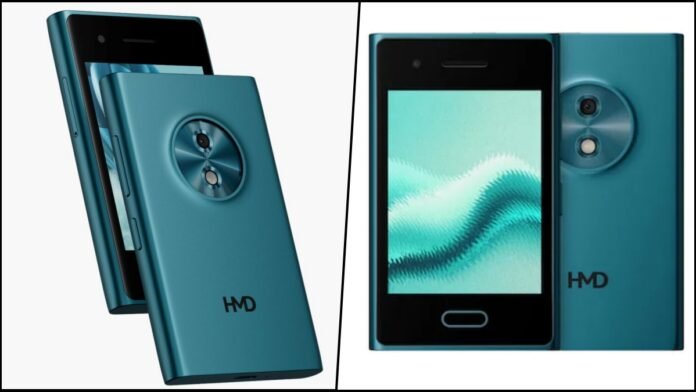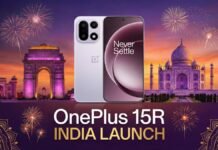
Key Points
- HMD launches Touch 4G, claiming it as India’s first hybrid smartphone-feature phone in October 2025
- Priced affordably at ₹3,999, bridging gap between feature phones and smartphones
- Features 3.2-inch touchscreen (320×240 pixels) with video calling capability through Express Chat app
- Powered by Unisoc T127 processor running RTOS Touch operating system, not Android
- Includes 0.3MP front camera, 2MP rear camera with LED flash
- Cloud Phone Service provides live cricket updates, weather forecasts, and trending videos
- Equipped with 1,950mAh removable battery promising 30-hour backup with Type-C charging
- Minimal 64MB RAM and 128MB internal storage, expandable to 32GB via microSD
- IP52 rating for dust and splash resistance, WiFi hotspot and Bluetooth connectivity
- Available exclusively through HMD’s official website
New Delhi: HMD Global, the Finnish company manufacturing Nokia-branded mobile devices, has introduced an innovative new category in India’s mobile phone market with the launch of the Touch 4G in October 2025. The company positions this device as India’s first-ever hybrid phone, strategically designed to occupy the middle ground between traditional feature phones and modern smartphones—a segment that could appeal to millions of Indian consumers seeking smartphone-like features at feature phone prices.
The Touch 4G represents HMD’s understanding of the Indian market’s unique dynamics, where price sensitivity remains paramount while demand for connectivity features continues growing. By combining the affordability and simplicity of feature phones with select smartphone capabilities, HMD aims to capture users who find feature phones too limiting but smartphones too expensive or complex.
Design and Display Specifications
The HMD Touch 4G sports a compact 3.2-inch touchscreen display with a resolution of 320×240 pixels, significantly smaller than modern smartphones but larger than typical feature phone screens. This screen size strikes a balance between portability and usability, making it suitable for users with basic browsing and messaging needs.
While HMD has not disclosed the specific display panel technology used, the 320×240 pixel resolution suggests a basic LCD panel optimized for power efficiency rather than high-definition content consumption. The QVGA resolution, though modest by contemporary standards, proves adequate for the device’s intended use cases—messaging, basic web browsing, and video calls.
The compact form factor and touchscreen interface differentiate the Touch 4G from traditional button-based feature phones while maintaining the simplicity that feature phone users appreciate. This design philosophy targets users transitioning from basic phones who want touch functionality without the complexity of full smartphone operating systems.
Video Calling and Express Chat Integration
A standout feature distinguishing the Touch 4G from conventional feature phones is its video calling capability. Despite its entry-level positioning, the device supports video calls through the proprietary Express Chat application pre-installed on the device.
Express Chat functions as a comprehensive communication platform offering:
Instant Messaging: Text-based conversations similar to WhatsApp or other messaging apps
Group Chats: Multi-participant conversations enabling family and friend group communication
Video Calling: Real-time video communication despite the device’s basic hardware specifications
The strategic advantage of Express Chat lies in its cross-platform compatibility. HMD has developed Android and iOS versions of the application, meaning Touch 4G users can communicate seamlessly with friends and family members using smartphones. This interoperability addresses a critical limitation of traditional feature phones, which often struggle to connect with smartphone users’ preferred communication platforms.
For many potential buyers particularly elderly users, students, or those in rural areas this video calling capability combined with cross-platform messaging could justify the device’s purchase as a primary or secondary communication device.
Camera Capabilities
The Touch 4G includes dual cameras, though with extremely modest specifications reflecting its budget positioning:
Front Camera: 0.3-megapixel (VGA) sensor designed primarily for video calls rather than selfie photography
Rear Camera: 2-megapixel sensor with LED flash for basic photography needs
These camera specifications represent bare minimum functionality in 2025’s mobile landscape. The 2MP rear camera can capture basic photographs suitable for documentation purposes, sharing on messaging apps, or simple record-keeping, but users should not expect quality comparable to even budget smartphones.
The inclusion of an LED flash adds practical utility for low-light photography and can double as a flashlight—a frequently used feature in Indian households and work environments.
The 0.3MP front camera’s primary purpose is enabling video calls through Express Chat rather than selfie photography, aligning with the device’s focus on connectivity over content creation.
Cricket Updates and Cloud Phone Service
Demonstrating keen awareness of Indian consumers’ passions, HMD has integrated cricket-focused features into the Touch 4G. The device comes pre-loaded with Cloud Phone Service, a proprietary feature set providing:
Live Cricket Updates: Real-time scores, match progress, and cricket news—crucial for India’s cricket-obsessed population
Weather Forecasts: Localized weather information helping users plan daily activities
Trending Videos: Access to popular video content curated for the platform
HMD describes Cloud Phone Service as “a set of cloud-hosted browser shortcuts,” suggesting these features function through simplified web applications optimized for the device’s limited hardware and RTOS Touch operating system. This cloud-based approach enables feature-rich experiences without requiring powerful local processing or extensive storage.
The cricket focus particularly targets male users aged 18-45 who constitute cricket’s core following in India but may not own smartphones or want a secondary device specifically for staying connected to cricket updates without smartphone distractions.
Processor and Operating System
The Touch 4G runs on a Unisoc T127 processor, a low-power System-on-Chip (SoC) designed specifically for entry-level devices. Unisoc (formerly Spreadtrum) specializes in affordable chipsets for emerging markets, making it an appropriate choice for this hybrid device category.
Notably, the Touch 4G does not run Android despite its touchscreen interface and app-like features. Instead, it operates on RTOS Touch—a Real-Time Operating System optimized for feature phones and IoT devices. RTOS platforms offer several advantages for devices in this category:
Power Efficiency: Significantly lower power consumption compared to Android, extending battery life
Faster Performance: Minimal background processes ensure responsive user interface despite limited RAM
Smaller Footprint: Requires far less storage space than Android, crucial for devices with 128MB storage
Simplified Security: Fewer attack vectors compared to full-featured smartphone operating systems
The RTOS Touch system likely resembles KaiOS or similar feature phone operating systems that support touch interfaces and basic applications while maintaining the efficiency of traditional feature phone software.
Connectivity Features
Despite its feature phone DNA, the Touch 4G includes several connectivity options typically associated with smartphones:
4G LTE Connectivity: Full support for India’s 4G networks, ensuring reasonable data speeds for browsing and streaming
WiFi Hotspot: The device can share its mobile data connection with other devices, functioning as a portable hotspot—particularly useful for users who want to occasionally connect laptops or tablets
Bluetooth: Wireless connectivity for headsets, speakers, or file transfers
Type-C Charging: Modern USB Type-C port rather than outdated microUSB, improving charging convenience and future-proofing
The WiFi hotspot capability adds unexpected utility, potentially positioning the Touch 4G as an affordable portable internet solution in areas with limited broadband access.
Battery Life and Durability
The Touch 4G packs a 1,950mAh removable battery a capacity that would be inadequate for smartphones but proves substantial for a feature-phone-class device. HMD claims the battery delivers up to 30 hours of usage on a single charge, an impressive figure that reflects the power efficiency of the Unisoc T127 processor and RTOS Touch operating system.
The removable battery design offers practical advantages increasingly rare in modern mobile devices:
User Replacement: Users can carry spare batteries for extended trips without power access
Longevity: Degraded batteries can be replaced without requiring professional service
Cost Efficiency: Battery replacement costs significantly less than built-in battery service
Type-C charging support brings the device in line with contemporary charging standards, eliminating the need for separate microUSB cables and enabling faster charging speeds compared to older feature phones.
The IP52 rating provides basic protection against dust ingress and water splashes—not fully waterproof but sufficient to survive rain exposure, dusty environments, or accidental spills. This durability rating acknowledges that budget device users often work in challenging conditions where some environmental protection proves valuable.
Storage Configuration
The Touch 4G’s storage specifications represent perhaps its most significant limitation, featuring:
RAM: 64MB—extremely minimal by any standard
Internal Storage: 128MB barely sufficient for the operating system and pre-installed apps
Expandable Storage: MicroSD card support up to 32GB
These specifications, measured in megabytes rather than gigabytes, clearly position this as a basic communication device rather than a content consumption or storage platform. The 128MB internal storage likely leaves minimal space for user-installed applications, photos, or media files, making the microSD card expansion essential for practical use.
Users planning to store photos, music, or additional content will absolutely require a microSD card, adding to the effective cost of ownership beyond the base ₹3,999 price.
Emergency and Convenience Features
HMD has included a dedicated quick call button designed for two specific purposes:
Emergency Calls: One-touch access to emergency contacts or services—crucial for elderly users or those working in remote areas
Voice Message Recording: Quick audio note capture without navigating menus
This physical button represents thoughtful design for users who may struggle with touchscreen interfaces during stressful situations or who need rapid access to emergency communication.
Pricing and Availability
The HMD Touch 4G launches at ₹3,999 in India, positioning it competitively within the feature phone segment while undercutting budget smartphones by substantial margins. This price point targets several distinct customer segments:
First-Time Mobile Users: Individuals new to mobile phones who want touch functionality without smartphone complexity
Secondary Device Users: Smartphone owners wanting a simple backup device for specific purposes
Senior Citizens: Elderly users who need basic smartphone features without overwhelming interfaces
Budget-Conscious Buyers: Price-sensitive consumers unable or unwilling to spend ₹6,000+ on entry-level smartphones
Digital Detox Seekers: Users wanting reduced smartphone dependency while maintaining essential connectivity
The device is available exclusively through HMD’s official website, suggesting a direct-to-consumer sales strategy that eliminates retail margins and potentially enables the aggressive pricing.
Market Positioning and Competition
The Touch 4G enters a uniquely Indian market segment where feature phones continue selling millions of units annually despite smartphone proliferation. According to industry data, feature phones still account for approximately 45-50% of mobile phone sales in India, particularly in rural markets and among price-sensitive urban buyers.
Primary competition includes:
Traditional Feature Phones: Devices from Nokia, Lava, and Itel priced between ₹1,500-₹2,500 with button interfaces
KaiOS Devices: Smart feature phones from JioPhone series and others offering app support on feature phone hardware
Ultra-Budget Smartphones: Entry-level Android phones priced around ₹5,000-₹7,000 with limited specifications
The Touch 4G’s hybrid positioning attempts to capture users considering upgrades from basic feature phones but deterred by smartphone prices or complexity, as well as those looking for simpler alternatives to frustrating ultra-budget smartphones.
Verdict and Target Audience
The HMD Touch 4G represents an intriguing experiment in creating a middle category between feature phones and smartphones. Its success will depend on whether sufficient demand exists among users who genuinely want this specific combination of affordability, simplicity, and selective smartphone features.
Ideal buyers include elderly users needing video calling for family connection, students requiring basic connectivity for online classes without smartphone distractions, workers in rugged environments wanting durable communication devices, and anyone seeking digital minimalism while maintaining essential modern connectivity.
At ₹3,999, the Touch 4G offers reasonable value for its target audience, though buyers must accept significant compromises in storage, camera quality, and app ecosystem compared to budget smartphones costing just ₹2,000-₹3,000 more.







































